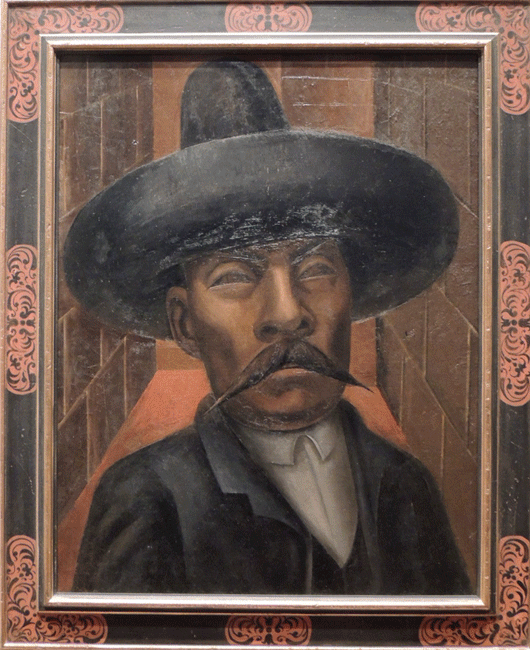Source: WTL photograph© at the Special Exhibition of "Paint the Revolution: Mexican Modernism 1910 - 1950," at the Philadelphia Art Museum, December 13, 2016.
Image:
"Zapata" (1931) by David Alfaro Siqueiros (1896-1974). Oil on canvas.
Comments: Emiliano Zapata (1879-1919) was one of the major protagonists in the revolt of the Mexican peasant masses against the ruling class during the Mexican Revolution (1910-20). Zapata was born in Anenecuilco, a small village in the sugarcane region of the state of Morelos. (Because it is Zapata's birthplace, Anenecuilco is a famous place in Mexican culture.) His parents belonged to the class of small landowners. When he was young Zapata joined protest movements against the presidential dictator Porfirio Díaz, who supported the monopolistic owners of the largest lands (haciendas). In 1910, Zapata then became a leader of the Revolution in southern Mexico by creating the Liberation Army of the South (Pancho Villa was the leader of the Liberation Army of the North). His army defeated the Díaz's federales (Federal Army) in the famous Battle of Cuautla in 1910. The next year Zapata created the Plan de Ayala, which advocated major land reforms with distribution of the large haciendas to peasants. However, the new leader of democratic forces in Mexico, Francisco I. Madero, waged a brutal military campaign against Zapata. Zapata won many victories for the peasants, but he was killed April 1919 by a traitor in his own army.
For another sequence showing a major mural by Siqueiros at the Palacio de Bellas Artes, see Pages 7 through 12 at: => Siqueiros.
For another image of Zapata in this series, see: => Modern Mexican Art #28.
For a full chronology of the Mexican Revolution, see: => Mexico.
For a brief mention in this textbook about Pancho Villa, see the #10 in the Museo de las Intervenciones located in the series on Coyoacón, Mexico: => Intervenciones.
For other paintings and murals by Siqueiros in this series on Mexican Modern art, see: => #4; => #16; => #27;and => #29.
Note that Zapata was such a popular defender--and martyr--of the Mexican peasantry that his name was used by the neo-Zapatistas in the 1994 to present uprising of the (mostly Mayan indigenous) Zapatista Army of National Liberation (Ejército Zapatista de Liberación Nacional, EZLN) in the southern state of Chiapas. At first the EZLA engaged in army resistance against the federal army but later it devolved into a movement of civil resistance. At first the non-Mayan spokeman was known as Subcomandante Marcos, but later changed his nom de guerre to Subcomandante Insurgente Galeano.
Humanities Questions: (A) Compare and contrast the photograph above of Emiliano Zapata with Siqueiros portrait of him. (B) Curious question: ponder the effect of the double frame (i.e., frame within frame) used to display Siqueiros' portrait of Zapata, and then write a short analysis of how this framing device enhances or detracts, in your opinion, from the portrait itself; hint: is there anything within the portrait itself that suggests the notion of mise en abyme (frame within frame...)?


